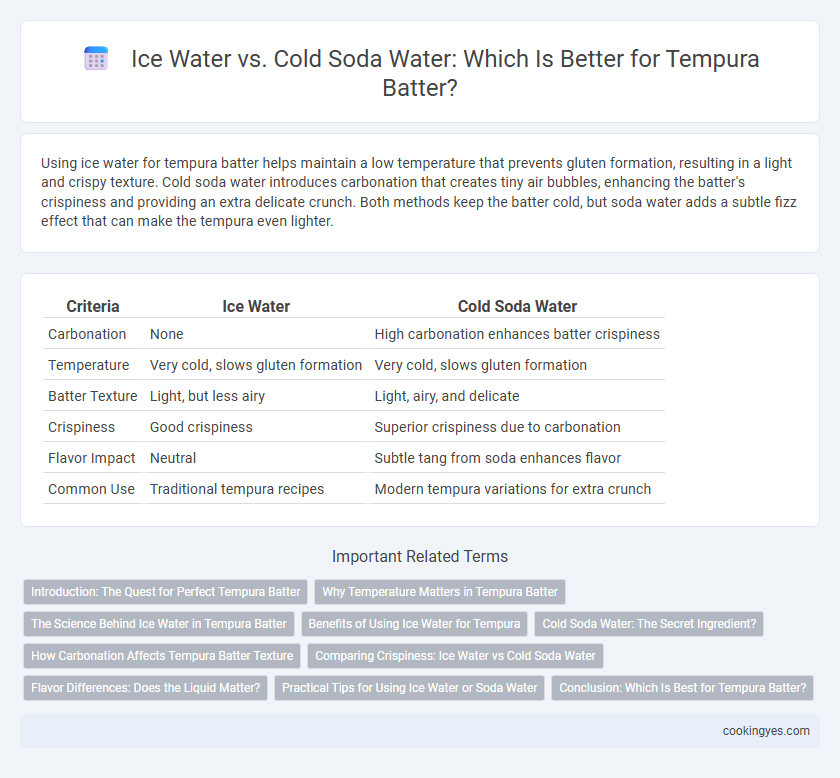Using ice water for tempura batter helps maintain a low temperature that prevents gluten formation, resulting in a light and crispy texture. Cold soda water introduces carbonation that creates tiny air bubbles, enhancing the batter's crispiness and providing an extra delicate crunch. Both methods keep the batter cold, but soda water adds a subtle fizz effect that can make the tempura even lighter.
Table of Comparison
| Criteria | Ice Water | Cold Soda Water |
|---|---|---|
| Carbonation | None | High carbonation enhances batter crispiness |
| Temperature | Very cold, slows gluten formation | Very cold, slows gluten formation |
| Batter Texture | Light, but less airy | Light, airy, and delicate |
| Crispiness | Good crispiness | Superior crispiness due to carbonation |
| Flavor Impact | Neutral | Subtle tang from soda enhances flavor |
| Common Use | Traditional tempura recipes | Modern tempura variations for extra crunch |
Introduction: The Quest for Perfect Tempura Batter
Ice water preserves the tempura batter's cold temperature, slowing gluten formation and resulting in a light, crispy texture. Cold soda water introduces carbonation that aerates the batter, enhancing crispiness and creating delicate bubbles for an airy finish. Both liquids contribute to the ideal tempura batter by ensuring a cold, lightly mixed mixture that produces a tender, crispy coating.
Why Temperature Matters in Tempura Batter
Ice water maintains a consistently low temperature in tempura batter, which is crucial for preventing gluten development and achieving the signature light, crispy texture. Cold soda water introduces carbonation that creates tiny bubbles, enhancing batter aeration and crispness while staying cold enough to inhibit gluten formation. The temperature of the batter directly affects batter viscosity and frying reaction, making ice-cold liquids essential for perfect tempura results.
The Science Behind Ice Water in Tempura Batter
Ice water in tempura batter slows gluten formation by keeping the batter cold, resulting in a lighter, crispier texture due to reduced protein activation. The low temperature prevents excessive starch gelatinization, maintaining an airy, crunchy coating. Cold soda water offers carbonation that adds extra crispness but lacks the pure temperature control essential for optimal tempura batter science.
Benefits of Using Ice Water for Tempura
Using ice water for tempura batter helps maintain a cold temperature that prevents gluten development, resulting in a lighter, crispier texture. The cold temperature slows the mixing process, reducing the risk of overworking the batter and creating a delicate, airy coating. Unlike cold soda water, ice water avoids added carbonation, allowing the natural batter ingredients to achieve optimal crispiness without altering flavor.
Cold Soda Water: The Secret Ingredient?
Cold soda water is the secret ingredient that enhances the crispiness of tempura batter by introducing tiny carbon dioxide bubbles, which create a lighter, airier texture. Unlike regular ice water, soda water's carbonation helps prevent the batter from absorbing excess oil, resulting in a delicate, crunchy coating. The consistent use of ice-cold soda water ensures optimal batter consistency and superior frying performance for authentic tempura.
How Carbonation Affects Tempura Batter Texture
Carbonation in cold soda water introduces fine bubbles that create a lighter, crispier texture in tempura batter by aerating the mixture more effectively than ice water. The carbon dioxide gas helps to produce a delicate, crunchy crust that resists oil absorption, enhancing the tempura's overall crispness. Using soda water chilled to a low temperature maximizes carbonation retention, optimizing the batter's texture and appearance.
Comparing Crispiness: Ice Water vs Cold Soda Water
Tempura batter achieves greater crispiness when made with cold soda water due to the carbonation creating tiny bubbles that expand during frying, resulting in a lighter and crunchier texture. Ice water can also yield a crispy batter by keeping the temperature low, which slows gluten formation, but it lacks the effervescent effect that enhances the crispiness distinct to soda water. Research on frying techniques shows cold soda water consistently produces tempura with superior crispness and a more delicate, airy coating compared to ice water-based batters.
Flavor Differences: Does the Liquid Matter?
Using ice water in tempura batter results in a light, crisp texture that emphasizes the natural flavor of the ingredients, while cold soda water adds subtle carbonation that can create a slightly airier, more delicate crust. The carbonation in soda water helps to form tiny bubbles that enhance crispiness without altering the basic flavor, whereas ice water maintains a pure, clean taste. Choosing between the two depends on whether you prefer a straightforward flavor with crispness or a delicately effervescent crunch in your tempura.
Practical Tips for Using Ice Water or Soda Water
Using ice water for tempura batter helps maintain a cold temperature, preventing gluten formation and resulting in a lighter, crispier texture. Cold soda water adds carbonation, creating air bubbles that enhance the batter's crispiness and delicate crunch. For best results, keep the batter cold and mix it lightly to preserve the bubbles, ensuring a perfect tempura coating.
Conclusion: Which Is Best for Tempura Batter?
Ice water is generally preferred for tempura batter because its lower temperature helps inhibit gluten formation, resulting in a lighter, crispier texture. Cold soda water introduces carbonation that can enhance crispiness, but the bubbles often dissipate quickly, reducing the effect. For consistently delicate tempura, ice water offers better control over batter viscosity and frying outcomes.
Ice water vs Cold soda water for Tempura batter Infographic

 cookingyes.com
cookingyes.com